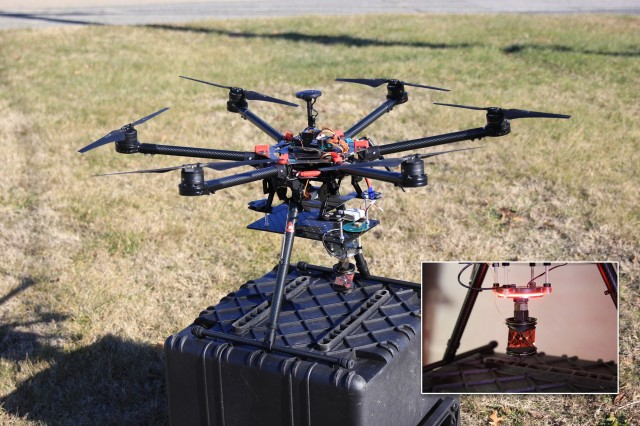Jun 12 2020
A unique open-air system implemented by the U.S. Army to test swarming drones boasts a capacity of over 1,500 times the volume of a normal testing facility.
 An unmanned aircraft system sports both a marker strobe (inset) and a traditional survey prism used to evaluate the accuracy of the motion-capture system. Image Credit: U.S. Army.
An unmanned aircraft system sports both a marker strobe (inset) and a traditional survey prism used to evaluate the accuracy of the motion-capture system. Image Credit: U.S. Army.
In the future, soldiers will use several such unmanned aircraft systems in the battlespace, with the help of an interconnected swarm to offer circumstantial awareness logistics, and defense abilities.
To facilitate the testing capability, the Army researchers collaborated with PhaseSpace, Inc., to design an innovative motion-capture feature that functions outdoors—where sunlight impedes motion-capture devices that are often used for applications like video game development.
This new capability enables us to expand the scale of our testing—from indoor testing in small rooms or spaces typically smaller than half of a basketball court, to now the size of five football fields.
Dan Everson, Researcher, Army Research Laboratory, U.S. Army Combat Capabilities Development Command
Everson added, “This will allow us to replicate more realistic UAS operation conditions and conduct experiments that were previously not possible, such as using cameras to navigate terrains, testing RF [radio frequency] communication within a swarm and flying larger drones.”
According to Everson, the system allows the laboratory to prioritize developments in human-agent teaming, counter-unmanned aircraft systems, ground/aerial agent interactions, heterogeneous swarming concepts, and multi-agent collaborative navigation technologies. The team has described the study outcomes in their technical report titled “Implementation and Evaluation of the World’s Largest Outdoor Optical Motion-Capture System.”
PhaseSpace designed the system to monitor motion, making brightly illuminated LED marker strobes that fix to the UAS test devices and move across the entire testing region.
The LED markers are monitored by 96 cameras installed within 16 tracking pods and placed around the perimeter of the testing region. The assessment of the Army-developed system illustrated precise marker tracking inside a space measuring 460 x 110 x 70 m—which is over 1,500 times as huge as a normal system measuring 15 x 15 x 10 m.
The measurement rate of the system is100 Hz, which implies that it quantifies the location of the markers 100 times per second.
The testing system is situated at APG, is transportable, and can be scaled up or down and even alter its shape. Everson believes collaborators in industry, academia, or the government can use this capability to test their research and development in robotics.
Our future Army will need to interact with a large number of autonomous agents to compete in future conflicts. The flexibility and scalability of this system will help the Army develop capabilities that will achieve overmatch against our adversaries.
Dan Everson, Researcher, Army Research Laboratory, U.S. Army Combat Capabilities Development Command
Technical Report:
Everson, D & Kline, B (2020) Implementation and Evaluation of the World’s Largest Outdoor Optical Motion-Capture System. doi.org/10.13140/RG.2.2.18046.95049.